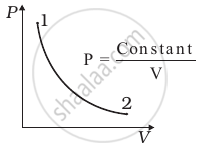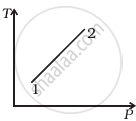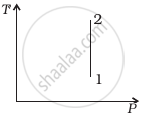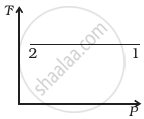Advertisements
Advertisements
Questions
Explain the cyclic process.
Explain cyclic process with the help of neat and labelled p-V diagram.
Solution
- A thermodynamic process that returns a system to its initial state is a cyclic process.
- In this process, the initial and the final state is the same.
- For a cyclic process, the total change in the internal energy of a system is zero. (ΔU = 0).
- According to the first law of thermodynamics, we have, for a cyclic process, Q = W
- The given figure shows the p-V diagram of a cyclic process which is a closed-loop.

p-V diagram of cyclic process - Working of all heat engines is a cyclic process.
APPEARS IN
RELATED QUESTIONS
Answer in brief.
Why should a Carnot cycle have two isothermal two adiabatic processes?
An ideal gas is taken through an isothermal process. If it does 2000 J of work on its environment, how much heat is added to it?
Heating a gas in a constant volume container is an example of which process?
Draw a p-V diagram of the reversible process.
State the assumptions made for thermodynamic processes.
Explain thermodynamics of the adiabatic process.
When food is cooked in a vessel by keeping the lid closed, after some time the steam pushes the lid outward. By considering the steam as a thermodynamic system, then in the cooking process
When you exercise in the morning, by considering your body as a thermodynamic system, which of the following is true?
Give the equation of state for an isothermal process.
Give an expression for work done in an isothermal process.
Give an equation state for an isochoric process.
Draw the PV diagram for the isochoric process.
What is a cyclic process?
Explain in detail the isothermal process.
Explain the isobaric process and derive the work done in this process.
Explain in detail the isochoric process.
For a given ideal gas 6 × 105 J heat energy is supplied and the volume of gas is increased from 4 m3 to 6 m3 at atmospheric pressure. Calculate
- the work done by the gas
- change in internal energy of the gas
- graph this process in PV and TV diagram
An ideal gas is expanded isothermally from volume V1 to volume V2 and then compressed adiabatically to original volume V1. If the initial pressure is P1, the final pressure is P3 and net work done is W, then ____________.
An ideal gas A and a real gas B have their volumes increased from V to 2V under isothermal conditions. The increase in internal energy ____________.
For an isothermal expansion of a perfect gas, the value of `(Delta "P")/"P"` is equal to ____________.
We consider a thermodynamic system. If `Delta"U"` represents the increase in its internal energy and W the work done by the system, which of the following statements is true?
Ideal gas for which 'ϒ' = 1.5 is suddenly compressed to `1/4`th of its initial volume. The ratio of 4 the final pressure to the initial pressure is ______.
`(ϒ = "C"_"p"/"C"_"v")`
Consider P-V diagram for an ideal gas shown in figure.

Out of the following diagrams (figure), which represents the T-P diagram?
 (i) |
 (ii) |
 (iii) |
 (iv) |
In a certain thermodynamical process, the pressure of a gas depends on its volume as kV3. The work done when the temperature changes from 100°C to 300°C will be ______ nR, where n denotes number of moles of a gas.
Explain how can a gas be expanded at constant temperature.
